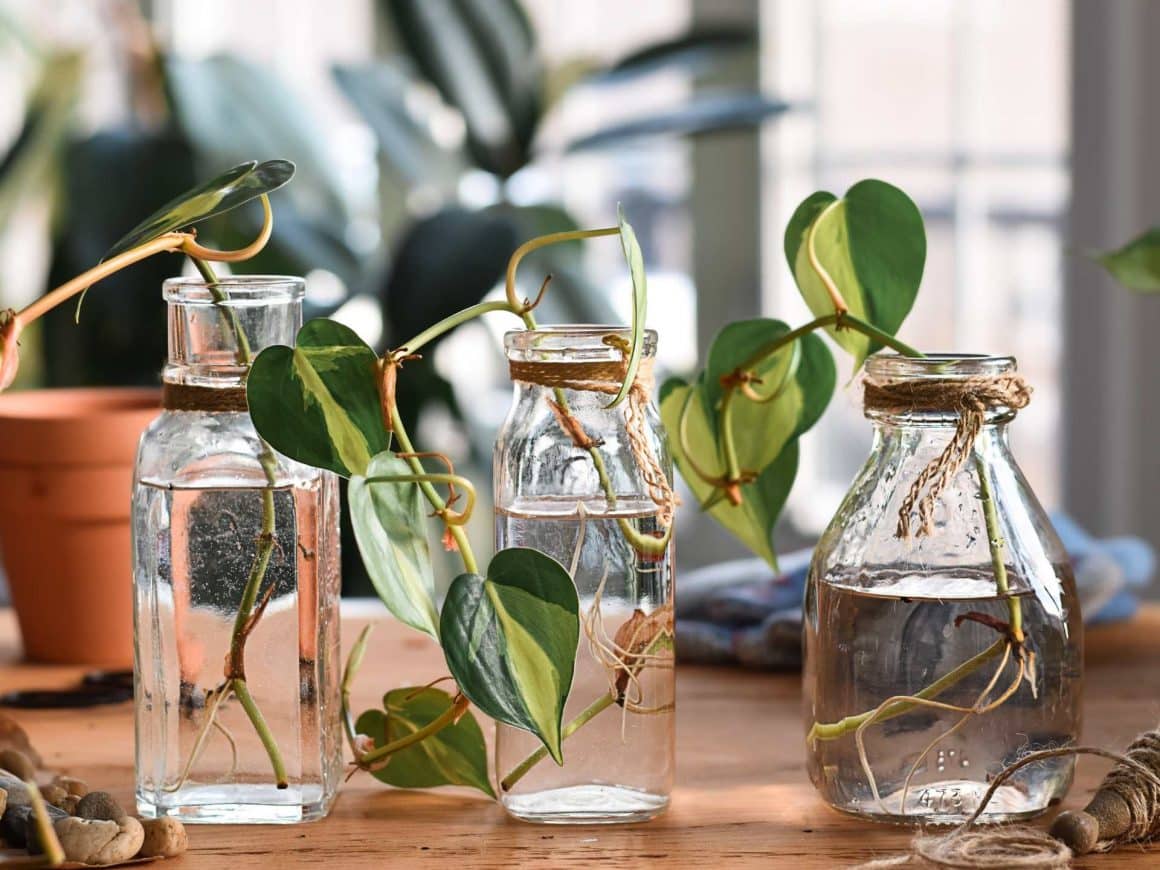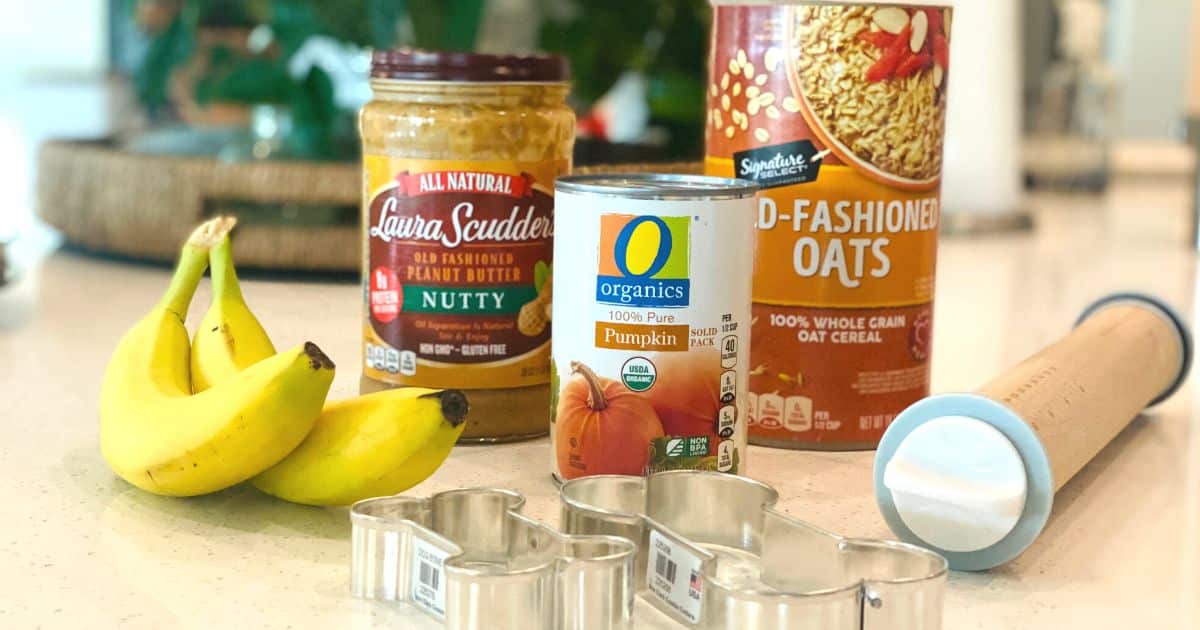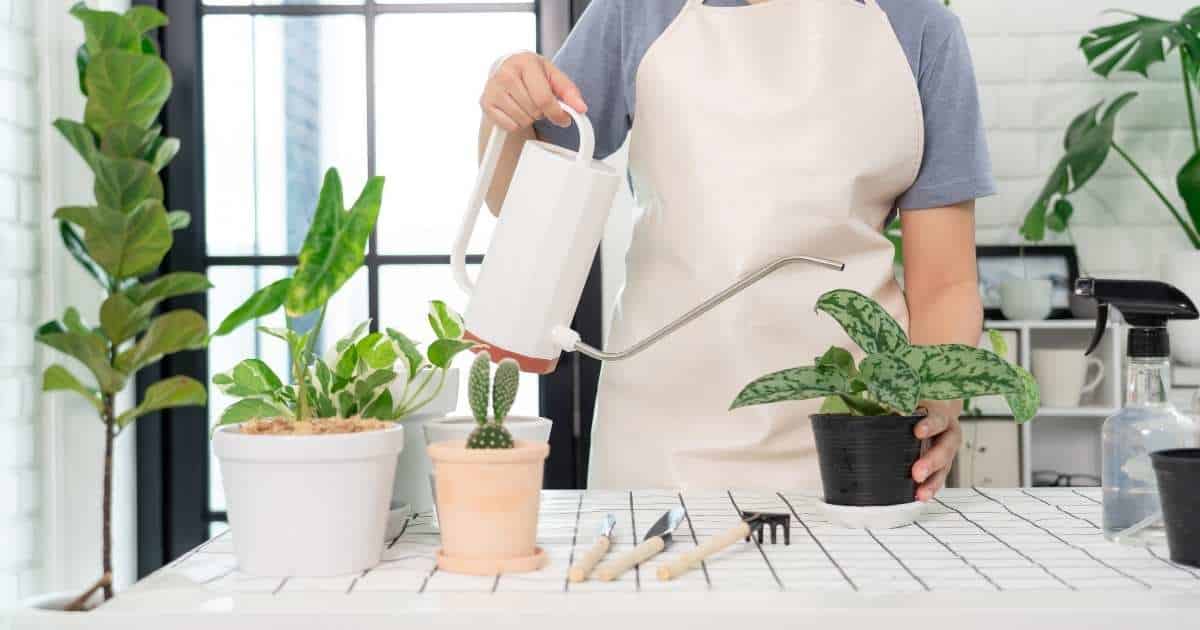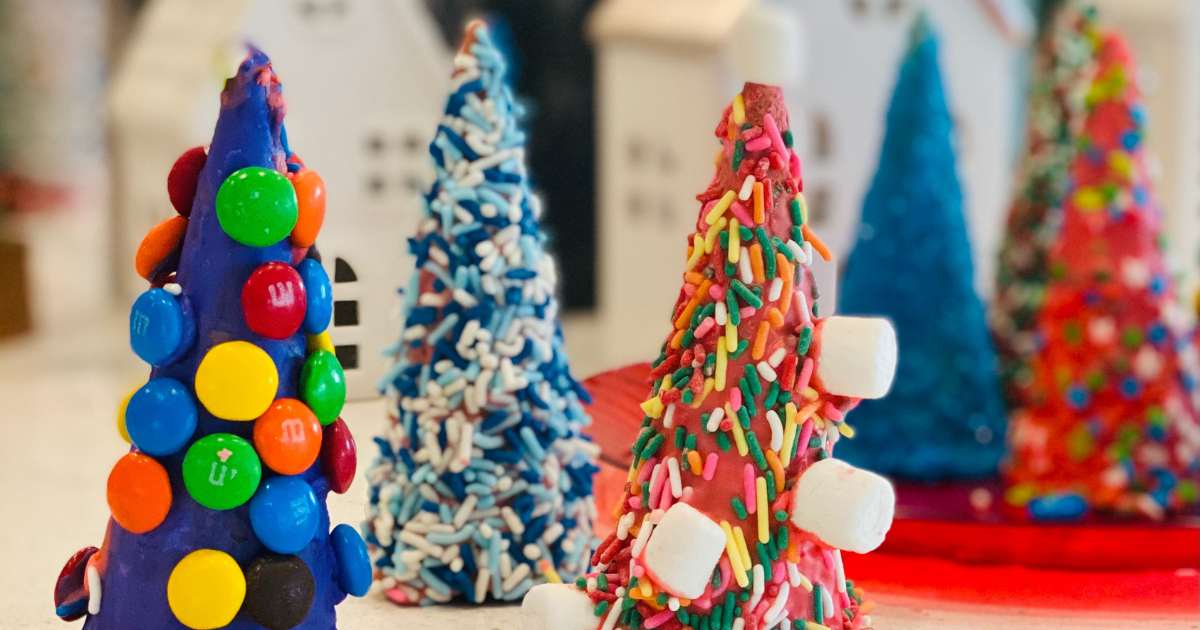How to Propagate Plants in Water in Just 5-Easy Steps!
Want free plants? You’ve come to the right place! Propagating plants in water is easy and fun!
In this guide, How to propagate plants in Water, you will learn everything you need to know to propagate plants in water in just 3-easy steps!
Propagating plants in water is so easy! As a proud plant mama of over 40 houseplants, I’ve been propagating plants for years, and it’s so much fun!
Using water propagation, you can create new plants from cuttings taken from existing plants in just a few easy steps.
Not only is propagating plants in water easy and a great way to get free plants! So what’s better than free plants?
This post may contain affiliate links. Read disclosure here
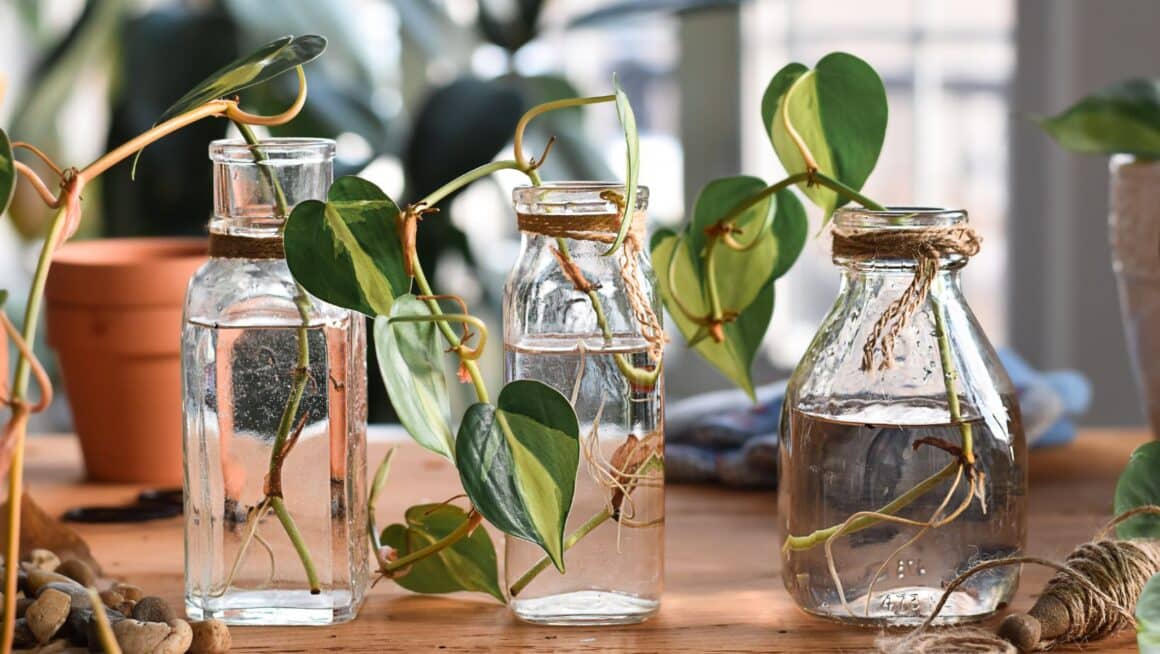
The Science Behind Propagating Plants in Water
What is Plant Propagation?
Propagation is essentially the process of creating new plants from existing ones.
This happens all the time in nature – through seeds, cuttings, and even leaves.
You can think of it as the plant world’s version of giving birth. But did you know you can replicate this process at home with just a glass of water? source
Why Water Propagation?
Water propagation offers several benefits over traditional soil propagation.
It’s easier, faster, and you can see the root development in real-time, which is satisfying and allows you to spot problems early on.
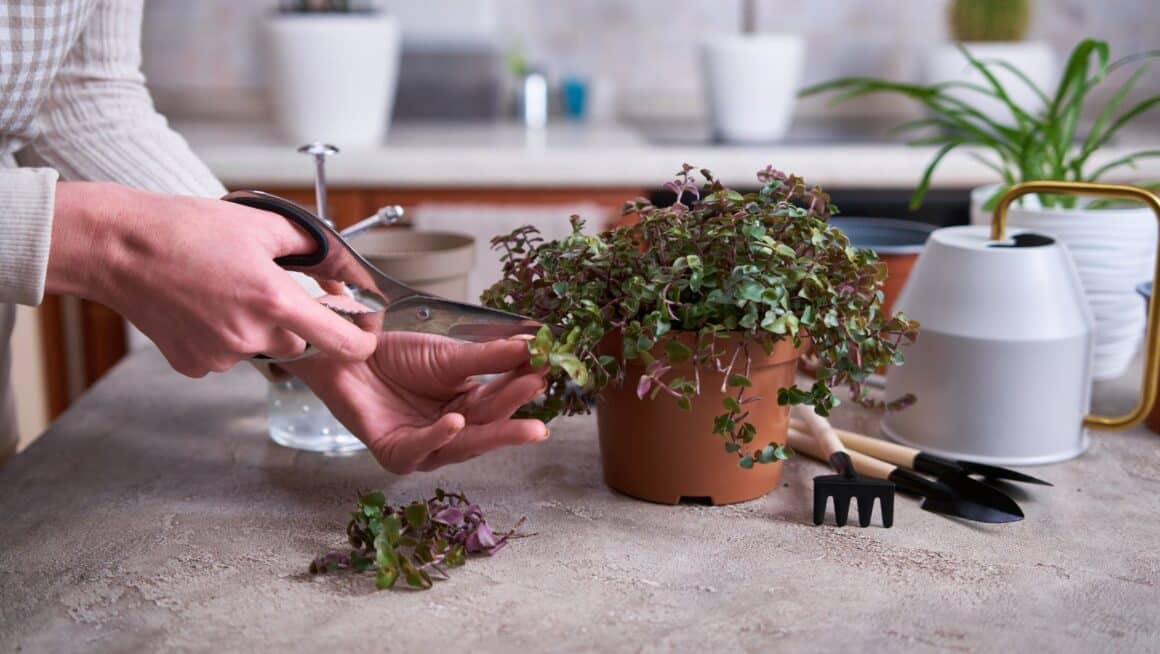
How to Propagate Plants in Water
Propating indoor plants in water is super easy and fast! Here are the step-by-step instructions on how to propagate plants in water.
Choose a healthy plant from which to take your cutting.
Choose a happy and healthy houseplant (or parent plant) before propagating plants in water. But first, make sure the plant is disease-free and has no pests.
Not all plants propagate well in water. Generally, plants that have softer stems or are naturally found near water bodies work best. Pothos, Philodendrons, spider plants, and the zz plant are great for beginners.
Find the leaf node
Identify a healthy, mature leaf on the plant. Cut a section of the stem just below a leaf node (the bump where leaves grow).
Ensure your cutting is 4-6 inches long and has 2-3 leaves remaining.
Cutting the plant at the leaf node will give your new plant the best chance of success.
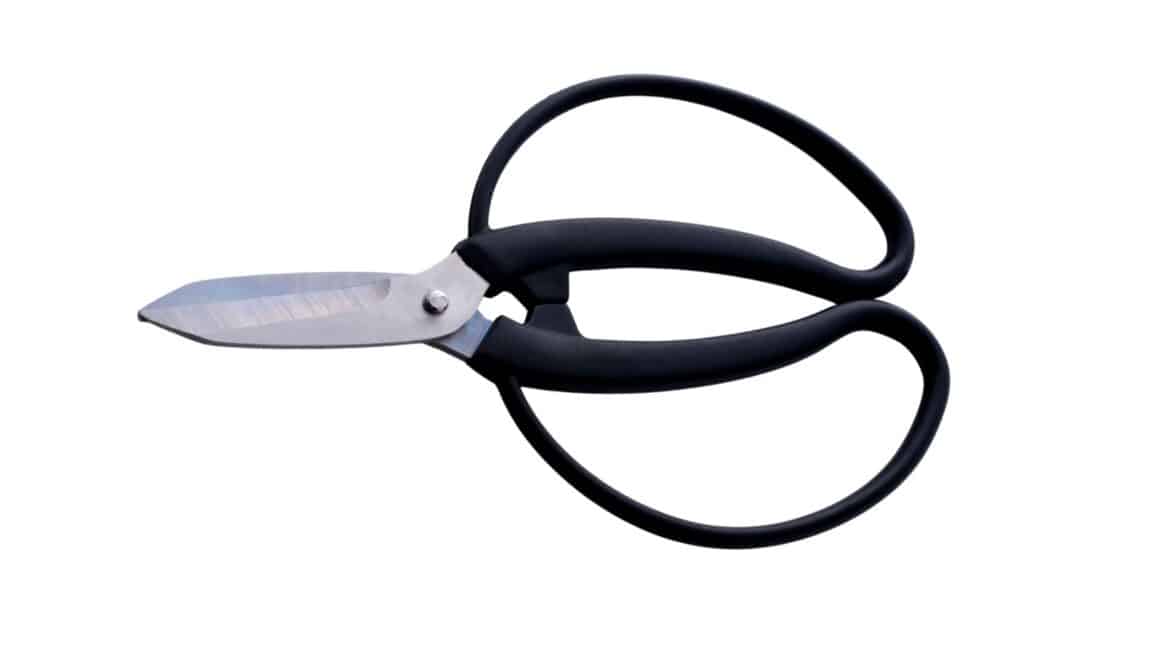
Cut a piece of stem from the mother plant.
Using plant scissors, cut a piece of stem from the mother plant at the node using a sharp knife or gardening scissors.
The cutting should be about four inches long and include at least two leaves. Once you have your cutting, remove the bottom leaves so that only the top leaves remain.
These top leaves will eventually become the new plant’s first true leaves.
Select Clear, Watertight Container
It’s best to use a clear container when propagating plants in water to see new root growth and the water level.
Any clear glass or plastic container works well for water propagation. You can use glass jars, small vases, and propagation stations to propagate houseplants in water.
Place Stem Cuttings in Fresh Water.
Fill the container with tap water and place your cutting inside.
When propagating plants in water, use clean, filtered water.
Make sure the stems of your cuttings are fully submerged in water. And remember to check the water level often. In addition, be sure to change with water out completely, getting rid of old, stagnant water to prevent root rot as roots grow.
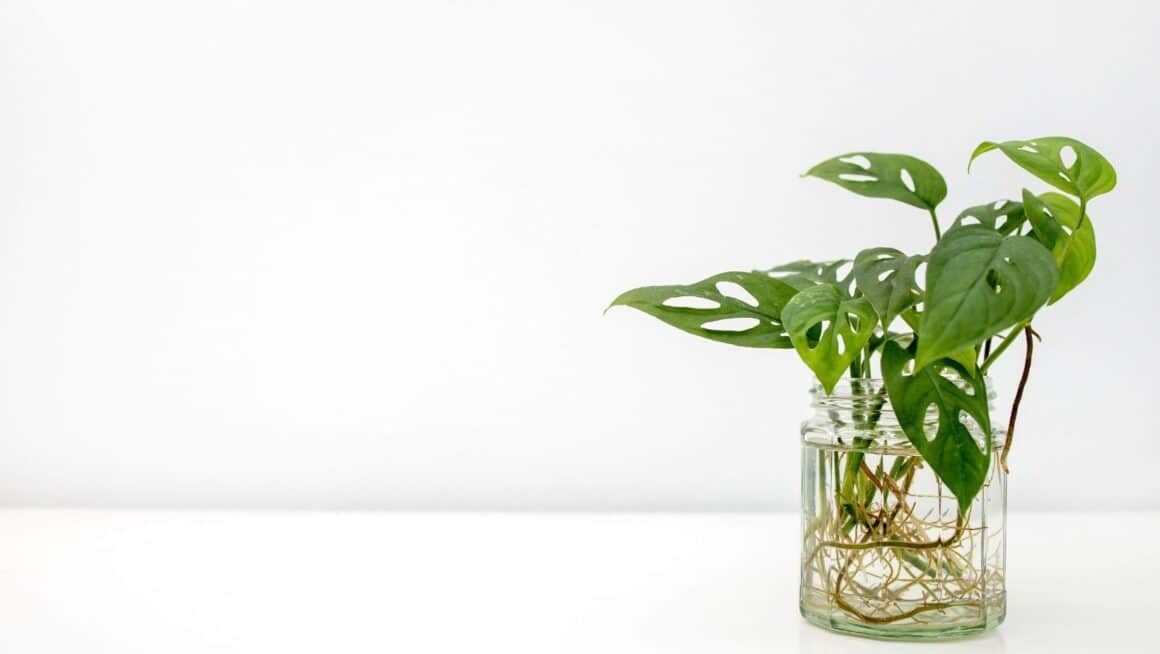
Put indirect Sunlight
For best results, place new cuttings in a sunny location with indirect light.
Wait. And Watch for New Growth
The time it takes for roots to grow can vary dramatically depending on the type of plant, the condition of the plant cuttings, the environment, and even the time of year.
Generally speaking, you might start to see tiny roots emerging from the nodes of your plant cutting within 1-3 weeks.
Once you see those little root nubs appear, it’ll be another few weeks before they’re robust enough to transition to the soil.
You’ll want to look for a solid root system a couple of inches long. This might take 2-6 weeks after the initial roots have formed.
So, from the day you put that cutting in water to the day it’s ready for its new soil home, it could be anywhere from 3-9 weeks.
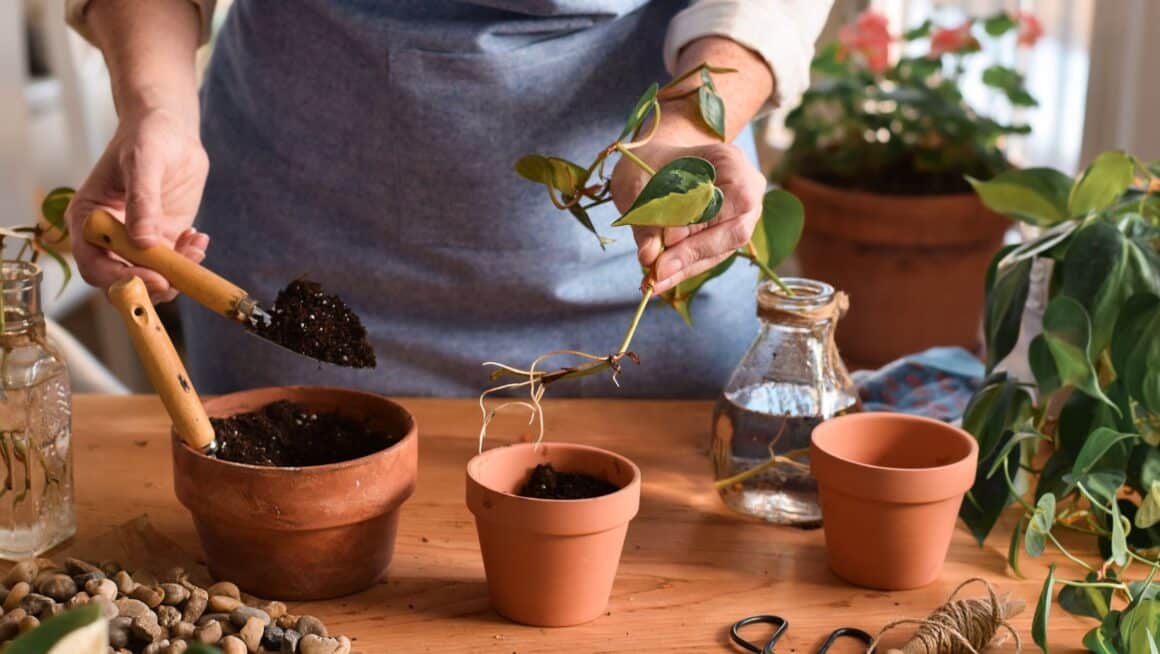
How to transplant your propagated plant into the soil:
Use a root stimulator to help cuttings grow.
A root stimulator is not required when planting rooted cutting but is a great way to encourage strong, healthy root growth on your propagated plants.
You can find root stimulators at your local garden center or nursery. Follow the instructions on the package and apply as directed.
Related Articles:
Use good quality potting soil to transplant your cuttings.
When planting your newly propagated plant, it’s essential to use high-quality potting soil.
Potting soil is specially formulated to provide the nutrients and drainage potted plants need to thrive.
Use a pot with proper drainage.
Make sure to use a pot with drainage holes in the bottom. Propagated plants will not do well if left sitting in waterlogged soil.
If you’re using a decorative pot without drainage holes, add a layer of rocks or gravel to the bottom before adding your potting mix and plant.
Water regularly
Keep your propagated plant watered, especially during the hot summer.
When watering, apply water directly to the soil, not the leaves.
It’s essential to place your newly propagated plant in a sunny window.
Propagated plants need at least six hours of sunlight each day.
If you cannot provide enough natural light, consider using grow lights to supplement the light your propagating plant receives.
Fertilize monthly
Don’t forget to fertilize your newly propagated plant!
Fertilizing your new plant baby will help promote healthy growth and prevent nutrient deficiencies.
Use the best fertilizer for houseplants and apply according to the directions.
It’s best to fertilize every two weeks during the growing season and once a month during the winter.
Related article: The best fertilizer for happy + healthy plants
The Easiest Houseplants to Propagate in Water
Some plants are easier to propagate in water than others. As a general rule of thumb, I would start with the easiest plants to propagate in water, such as the Pothos and the spider plant.
Here is a quick rundown of the best plants and the easiest plants to propagate in water:
Pothos (Epipremnum aureum)
A favorite among indoor gardeners, the Pothos is not just easy to care for but also propagates wonderfully in water. Just snip off a vine, place it in water, and watch it grow!
Philodendron
With their lush, tropical leaves, Philodendrons are an indoor gardener’s dream. Luckily, they’re just as easy to propagate as they are beautiful.
Monstera Deliciosa
Who can resist the Swiss cheese plant with its iconic fenestrated leaves? Monsteras love water propagation.
Just make sure your cutting has a node, and you’re good to go.
Spider Plant (Chlorophytum comosum)
Spider plants send off little babies, also known as spiderettes.
Snip these off and place them in water to start a new baby plant.
English Ivy (Hedera helix)
This charming climber can add a touch of elegance to any indoor space. Plus, it propagates like a dream in water.
Peace Lily (Spathiphyllum)
Got a Peace Lily at home? Great! Just divide it at the roots and place the cuttings in water. They’ll take a bit longer to root but watching them grow is just as rewarding.
Lucky Bamboo (Dracaena sanderiana)
Although not a true bamboo, it loves water and can be propagated by simply cutting off a stalk and placing it in a water-filled container.
Snake Plant (Sansevieria)
Also known as mother-in-law’s tongue, snake plants are super tough and can be propagated in water, although it’s a slower process.
African Violet (Saintpaulia)
You can propagate these cute little plants by using leaf cutting. Place it in water, and watch the roots grow!
Outdoor plants that can be propagated in water
- inpatients
- coleus
- geraniums
- ivy
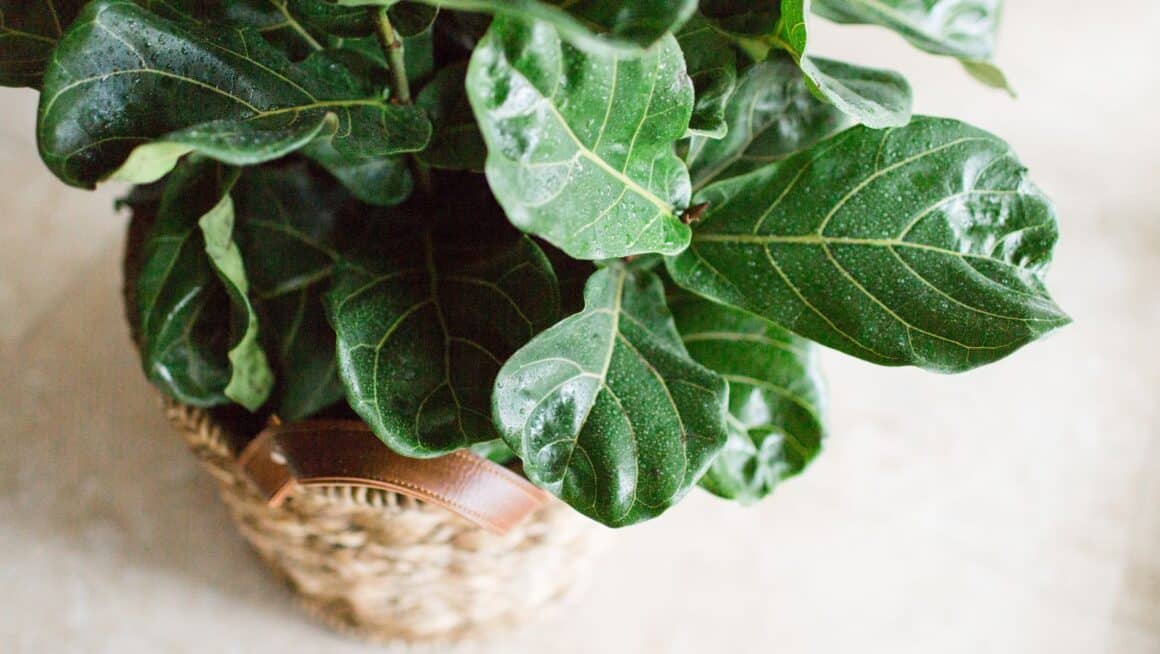
Plants that don’t propagate well in Water.
While it’s exciting to watch roots spring to life in a water-filled jar, some plants, especially woody types, can be a bit more challenging to propagate in water.
Most plants can be propagated using different methods such as soil propagation, air layers and dividing.
Plants that don’t propagate well in water:
Fiddle Leaf Figs (Ficus lyrata)
Fiddles can be a bit fussy when it comes to water propagation. While not impossible, it’s more challenging and time-consuming than soil propagation.
Cacti and Succulents
These desert dwellers generally don’t do well with water propagation as they’re more prone to rot. They typically prefer a dry propagation method, such as leaf or stem cuttings in soil.
Orchids
Propagating orchids in water, known as water culture, can be tricky.
It requires careful monitoring of water levels and conditions; success isn’t guaranteed.
Most Woody Plants
As a rule of thumb, woody plants like some varieties of hibiscus, camellia, and many fruit trees don’t propagate well in water.
They generally require a different method of propagation.
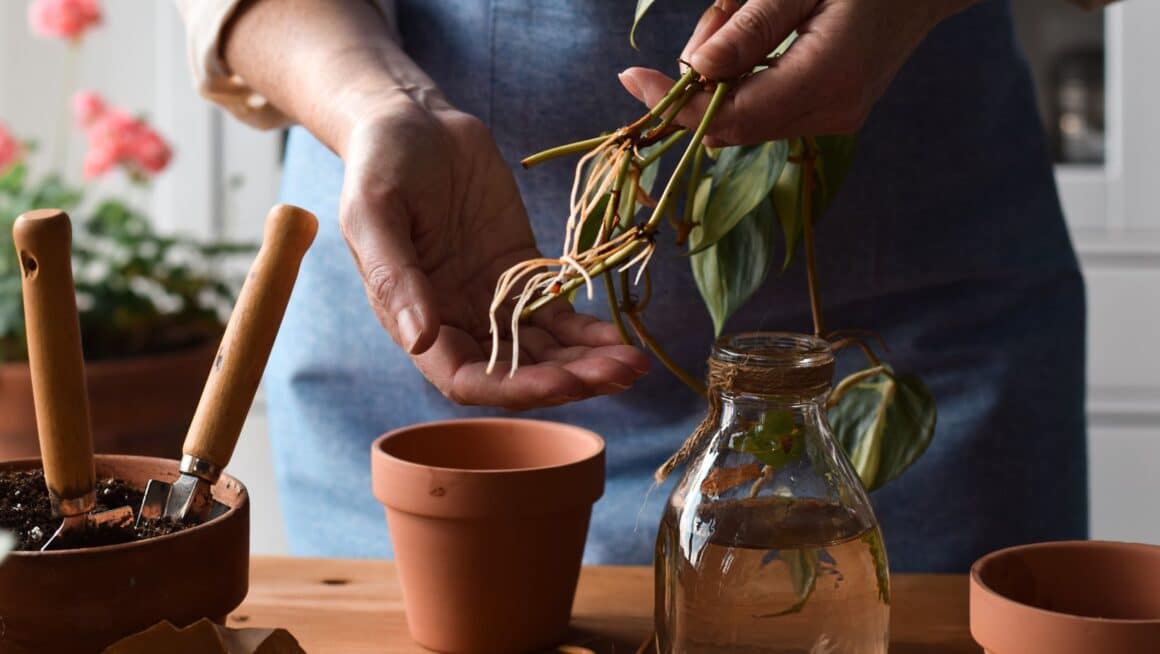
Other Methods of Propagating Plants
Water propagation is just one method of propagation.
There are several other ways you can create new plants from the ones you already have.
Soil Propagation
This is a common method, similar to water propagation, but you stick the cutting directly into a potting mix instead of water. With this method, plants often transition easier into growing in soil since they’re already there!
Air Layering
This is a fascinating method where you encourage the plant to grow roots while it’s still on the parent plant! You make a small cut on the plant’s stem, wrap it in moist sphagnum moss, and then wrap that in plastic. source
After a while, roots will start growing from the cut. Once you see a healthy root ball, you can cut the stem off the parent plant and pot it up.
Division
This method works well for plants that grow in clumps, like hostas or snake plants. It’s as simple as it sounds – you divide the plant into smaller parts, each with its own root system, and then pot them up separately.
Leaf Cuttings
Some plants can form an entirely new plant from just a single leaf! You take a healthy leaf, make a cut across the main vein, and then lay it flat on potting soil.
With a bit of patience, you’ll see tiny plantlets begin to form along the cut vein. Succulents like jade plants and African violets are common plants propagated this way.
Stem Cuttings
Like water propagation, these cuttings are typically planted directly into the soil using rooting hormone. It’s the best way to propagate woody plants like roses or hydrangeas.
Layering
This method involves bending a low-growing, flexible branch to the ground, covering a part of it with soil, and then staking it down.
Over time, the buried part of the branch will grow roots and can then be cut from the parent plant and transplanted. source
Grafting
This is a more advanced method where you attach a part of one plant onto another, and they fuse and continue growing as one. It’s commonly used for fruit trees. source
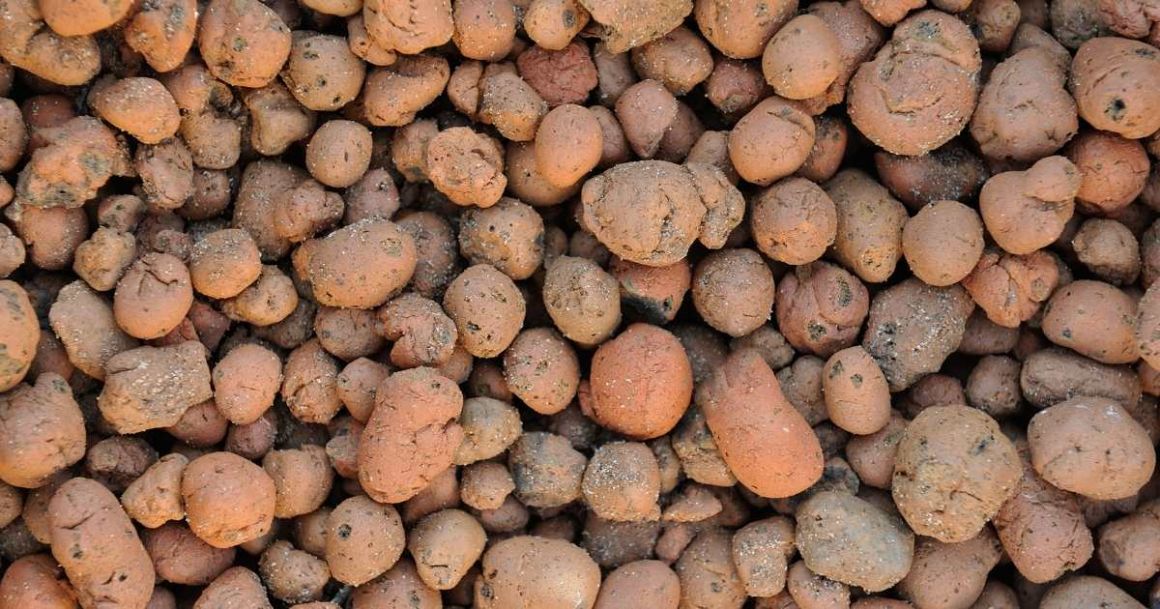
Extras: Clay pebbles+ Sphagnum moss
Propagating Plants in Water Using Clay Pebbles
You can also propagate plants in water using clay pebbles.
To do this, fill a container with clay pebbles and place your cutting on top. Next, fill the container with water to wet the clay pebbles.
Place the container in a bright spot from direct sunlight and moisten the clay pebbles by adding water.
You’ll see new roots start to grow in just a few weeks.
Once the roots are about an inch long, you can transplant your new plant into the soil or its permanent home.
Benefits of using clay pebbles
The benefits of using clay pebbles when propagating plants in water are that they provide extra aeration to the roots and help to keep the water clean.
Clay pebbles help keep the cutting stable in its new container while rooting.
Clay pebbles are also reusable so that you can use them repeatedly.
Related: How to use Clay Pebbles to Propagate Plants
Using Sphagnum moss for Propagating Plants.
To use sphagnum moss when propagating plants in water, soak it in water until thoroughly saturated. Then, squeeze out excess water and place the moss in a container.
Make a hole in the center of the moss and insert your cutting.
Keep the moss moist by misting it with water every few days.
The benefits of using sphagnum moss when propagating plants
There are many great ways to use sphagnum moss when propagating plants.
Sphagnum moss retains moisture well and provides a supportive environment for growing roots. Sphagnum moss is also sterile, so it’s less likely to harbor diseases.
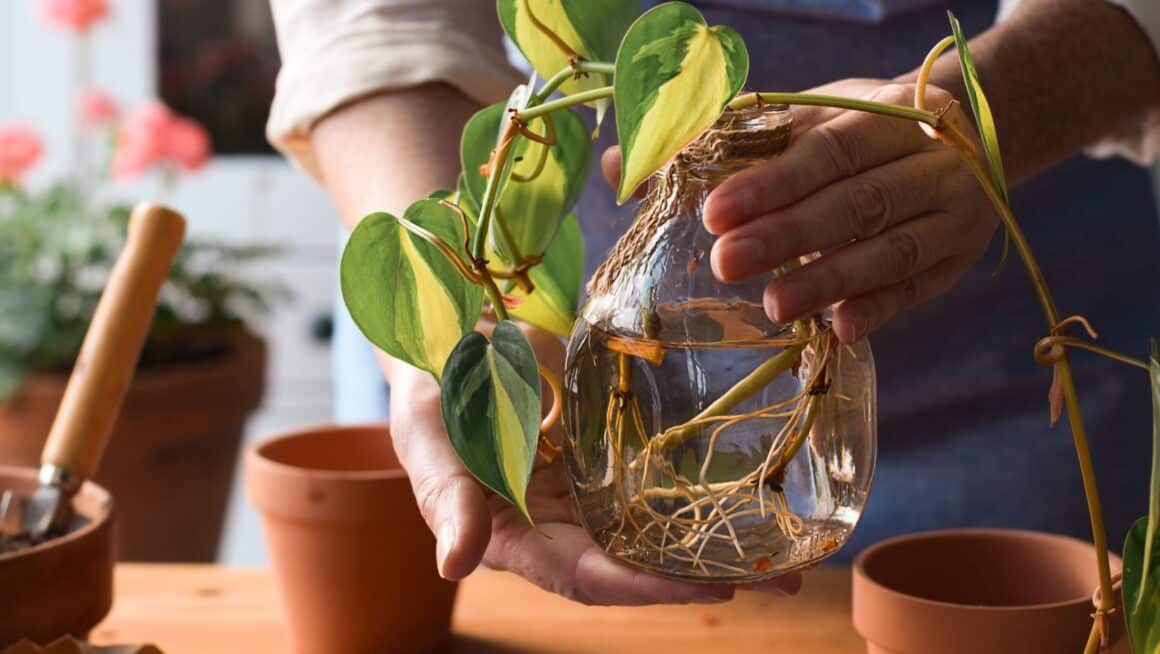
FAQs: How to Propagate Plants in Water
Q: How often should I change the water in my propagation vessel?
A: It’s best to change the water once a week to prevent the growth of bacteria and algae.
Q: Can I propagate any plant in water?
A: While many plants propagate well in water, some do not. It’s always a good idea to research your specific plant before starting.
Q: What do I do if my cutting isn’t sprouting roots?
A: Firstly, don’t panic! Some plants take longer than others. However, if after a few weeks you don’t see any change, it might be best to start over with a new cutting.
Q: Should I use tap water for propagation?
A: Yes, tap water is fine for most plants. However, if your tap water is heavily chlorinated, it might be best to let it sit out overnight before using.
Q: Can I leave my plant in water indefinitely?
While some plants can live in water indefinitely, most prefer to be potted in soil once they have a healthy root system.
Conclusion: How to Propagate Plants in Water.
Give propagating plants a try and see how easy it is to get free plants.
With patience, you will have a beautiful collection of happy, healthy houseplants for little money before you know it.
Houseplants make lovely gifts too!
So what are you waiting for?
Get propagating!
XO, Christine

I’ve been keeping it real since 1963. 🙂
I’m a child of God, a wifey, mama, grandma, full-time creative, domestic engineer, and self-care enthusiast.
I am obsessed with all things makeup and skincare and love getting my hands dirty out in the garden, my art room, or in the kitchen, whipping up something yummy for the fam.
I’m always down to chat and love collaborating with other creatives and brands alike!
Feel free to reach out anytime!




